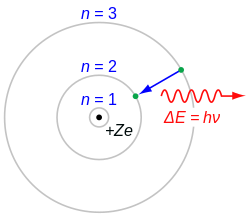Photon

Photons (from Greek φως, meaning light), in many atomic models in physics, are particles which transmit light. In other words, light is carried over space by photons. Photon is an elementary particle that is its own antiparticle. In quantum mechanics each photon has a characteristic quantum of energy that depends on frequency: A photon associated with light at a higher frequency will have more energy (and be associated with light at a shorter wavelength).
Photons have a rest mass of 0 (zero). However, Einstein's theory of relativity says that they do have a certain amount of momentum. Before the photon got its name, Einstein revived the proposal that light is separate pieces of energy (particles). These particles came to be known as photons.
Properties
Photons are fundamental particles. Although they can be created and destroyed, their lifetime is infinite.
In a vacuum, all photons move at the speed of light, c, which is equal to 299,792,458 meters (approximately 300,000 kilometers) per second.
A photon has a given frequency, which determines its color. Radio technology makes great use of frequency. Beyond the visible range, frequency is less discussed, for example it is little used in distinguishing between X-Ray photons and infrared. Frequency is equivalent to the quantum energy of the photon, as related by the Planck constant equation,
- [math]\displaystyle{ E=hf }[/math],
where [math]\displaystyle{ E }[/math] is the photon's energy, [math]\displaystyle{ h }[/math] is the Planck constant, and [math]\displaystyle{ f }[/math] is the frequency of the light associated with the photon. This frequency, [math]\displaystyle{ f }[/math], is typically measured in cycles per second, or equivalently, in Hz. The quantum energy of different photons is often used in cameras, and other machines that use visible and higher than visible radiation. This because these photons are energetic enough to ionize atoms.
Another property of a photon is its wavelength. The frequency [math]\displaystyle{ f }[/math], wavelength , and speed of light [math]\displaystyle{ c }[/math] are related by the equation,
- [math]\displaystyle{ c = f\lambda }[/math],
where [math]\displaystyle{ \lambda }[/math] (lambda) is the wavelength, or length of the wave (typically measured in meters.)
Another important property of a photon is its polarity. If you saw a giant photon coming straight at you, it could appear as a swath whipping vertically, horizontally, or somewhere in between. Polarized sunglasses stop photons swinging up and down from passing. This is how they reduce glare as light bouncing off of surfaces tend to fly that way. Liquid crystal displays also use polarity to control which light passes through. Some animals can see light polarization.
Finally, a photon has a property called spin. Spin is related to light's circular polarization.
Photon interactions with matter
Light is often created or absorbed when an electron gains or loses energy. This energy can be in the form of heat, kinetic energy, or other form. For example, an incandescent light bulb uses heat. The increase of energy can push an electron up one level in a shell called a "valence". This makes it unstable, and like everything, it wants to be in the lowest energy state. (If being in the lowest energy state is confusing, pick up a pencil and drop it. Once on the ground, the pencil will be in a lower energy state). When the electron drops back down to a lower energy state, it needs to release the energy that hit it, and it must obey the conservation of energy (energy can neither be created nor destroyed). Electrons release this energy as photons, and at higher intensities, this photon can be seen as visible light.
Photons and the electromagnetic force
In particle physics, photons are responsible for electromagnetic force. Electromagnetism is an idea that combines electricity with magnetism. One common way that we experience electromagnetism in our daily lives is light, which is caused by electromagnetism. Electromagnetism is also responsible for charge, which is the reason that you can not push your hand through a table. Since photons are the force-carrying particle of electromagnetism, they are also gauge bosons. Some matter–called dark matter–is not believed to be affected by electromagnetism. This would mean that dark matter does not have a charge, and does not give off light.
Photon Media
The cone shows possible values of wave 4-vector of a photon. The "time" axis gives the angular frequency (rad⋅s−1) and the "space" axis represents the angular wavenumber (rad⋅m−1). Green and indigo represent left and right polarization.
Thomas Young's double-slit experiment in 1801 showed that light can act as a wave, helping to invalidate early particle theories of light.: Script error: The function "hyphen2dash" does not exist. 
Up to 1923, most physicists were reluctant to accept that light itself was quantized. Instead, they tried to explain photon behaviour by quantizing only matter, as in the Bohr model of the hydrogen atom (shown here). Even though these semiclassical models were only a first approximation, they were accurate for simple systems and they led to quantum mechanics.
Photoelectric effect: the emission of electrons from a metal plate caused by light quanta – photons
Stimulated emission (in which photons "clone" themselves) was predicted by Einstein in his kinetic analysis, and led to the development of the laser. Einstein's derivation inspired further developments in the quantum treatment of light, which led to the statistical interpretation of quantum mechanics.
Different electromagnetic modes (such as those depicted here) can be treated as independent simple harmonic oscillators. A photon corresponds to a unit of energy E = hν in its electromagnetic mode.
Feynman diagram of two electrons interacting by exchange of a virtual photon.
Related pages
+{{{1}}}−{{{2}}}






